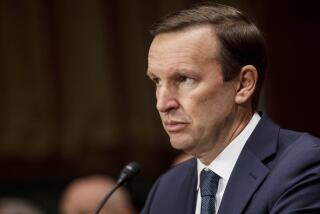Pentagon Spending Casts a Shadow Over Academia
BOSTON — It is difficult to imagine two worlds moredissimilar, the military and the university: the first regimented, secretive and single-minded; the second, pluralistic, open, and inquisitive. Yet for several decades, the two have been locked in uneasy embrace, serving the military’s need for top-flight technical talent to invent an increasingly technological armed forces.
Colleges have cooperated out of a sense of duty and a practical need for funds, but like any marriage of convenience, the partnership has been rocky. With President Reagan’s ambitious science-based rearmament, the alliance between the campus and the Pentagon is again being closely examined.
At the Massachusetts Institute of Technology, one of the nation’s most prestigious science and engineering schools, this burgeoning concern led the faculty to investigate the extent of the Defense Department’s reach into campus affairs. MIT, which receives more Pentagon dollars than any other school, has released a detailed study that reveals a growing, but perhaps not yet encumbering, military role at the institute. The report may resonate at California campuses as well, where issues of defense vs. academics have repeatedly been fought.
Worries about military influence on academic freedom have been rekindled by growing defense budgets and by Reagan’s “Star Wars” plan, the Strategic Defense Initiative. The military share of all federal research and development, for example, has grown from 50% in 1980 to 72% today. SDI is now a particular source of friction. The prospects for a missile defense depend on hundreds of future technical innovations, so top university researchers figure prominently in SDI plans, which include sharply rising budgets. At a minimum, many scientists are wary of the impact of such aggressive research and development on other research priorities.
Academics were upset when James Ionsen, head of the SDI Innovative Science & Technology program, publicly described grants to individuals at several prestige campuses as to a “university consortium.” Marvin Goldberger, president of Caltech, rebuked Ionsen’s claim as “manifestly false” and politically manipulative. In even angrier words, MIT President Paul Gray said in his 1985 commencement address that SDI managers were attempting to “short-circuit debate and use MIT and other institutions as political instruments in an attempt to obtain implicit institutional endorsement. This university will not be so used.”
In this tense environment the MIT faculty committee, headed by Prof. Carl Kaysen, set out on a special fact-finding mission. The committee took nearly a year to gather the views of faculty and students and data on defense contracts at the Cambridge campus. The findings were presented to the whole MIT community late last month.
“A substantial part of the faculty is concerned that the terms on which the Defense Department has supported research in the past are going to change,” Kaysen said in an interview. “I think they are correctly concerned. They’re not dreaming. The signs are in the air.”
The share of Pentagon grants to MIT has increased only from 16% of all on-campus research money to 16.8% in the last year but the school is already America’s fourth-largest defense contractor, trailing Boeing, TRW and Hughes. In 1984, MIT received more than three times the number of prime contracts awarded the University of California in Berkeley. A nine-year average shows MIT holding nearly twice as many defense contracts as Stanford and nearly three times the number at UC San Diego.
The faculty report, however, suggests the quality of campus-military ties, rather than the quantity, is the core of the dispute. Some fear new constraints. At times in the last three years, the Department of Defense has intimated it might demand the exclusion of non-U.S. citizens from its projects. Or it could insist that all project workers--including students--obtain security clearances, even though MIT (like Caltech and UC) conducts no classified research on campus.
Other faculty worries, as expressed in a questionnaire to which 45% responded, include prepublication review of research and permission to classify research at a later date. Both conditions could sap the lifeblood of science--free exchange of information--and jeopardize the careers of researchers, who must publish their work to advance. Most schools, including UC, have rules prohibiting research under such conditions; the fear now is that Defense will try to force changes.
Kaysen, an economist who served as deputy national security adviser to President John F. Kennedy, suggests a wider problem: “The federal agencies funding military-related research--the Defense and Energy departments and the National Aeronautics and Space Administration--used to support science and basic engineering because they thought this broad application was useful. The concern today is that they’re adopting a narrow view, they want things functionally useful for defense purposes.” That tighter, mission-oriented mind set is viewed as being at odds with the less confining nature of academic research.
In some key areas, the military presence in dollars is quite prominent. In 1984, the Pentagon supported 36% of research in engineering at MIT. The computer science lab, one of the world’s best, was 71% military-funded, and the artificial intelligence lab was 64% Defense-funded in 1984. The labs owe existence to the Pentagon, which most agree has so far been benignly non-intrusive. These funding patterns generally reflect similar concentrations of Defense dollars at top California schools.
Although the increase in the Defense Department’s share of all MIT research--which will total about $260 million this year--has been modest, the study indicates that the shift toward military applications may be quickening: “A quarter of the respondents reported shifts in the direction of their research,” the summary states, with “some net shift away from basic science and some increase in specifically military research.”
This federal research-and-development trend troubles many scientists. The growing availability of money from the Pentagon--and the concurrent decline in non-miliitary sources--may subtly influence researchers to gear their work toward military applications. “It could bias the direction of research,” noted George Rathjens, a former defense official now at MIT’s Center for International Studies. “It’s happened in my own case; it’s a great temptation if you have graduate student assistants to support.”
The Kaysen panel did not take up the issue that so often rankles UC academics--the school’s relationship to its military labs. MIT’s Lincoln Laboratory, with a $240-million budget mainly from the Air Force and Army, is essentially a military think tank; it has little daily interaction with MIT faculty or students. The lab does not design weapons--which perhaps makes it less objectionable than Livermore and Los Alamos labs are to some Californians--but faculty members question whether an academic institution should be in the business of managing a research center for the Pentagon that accrues little benefit to the university.
Such broad, philosophical questions about the proper role of the military in university life were not a major issue for the faculty committee. “People seem less allergic to defense support now,” Kaysen said. “I guess a rather small minority, perhaps less than 20%, would say MIT should not accept Pentagon money.” A follow-up committee will, however, assess policy implications of the Kaysen panel’s findings.
Faculty sentiments were gathered and analyzed well before the latest SDI imbroglio, which seems to have created fresh resentment. A few days before the report was released, the Pentagon’s chief of research and development, Donald Hicks, told Science magazine, “I am not particularly interested in seeing department money going to someplace where an individual is outspoken in his rejection of department aims, even for basic research.” In a later interview, Hicks said, in regard to SDI critics, “I have a hard time with disloyalty.”
Such statements do not sit well even with conservative academics. “The Hicks statement offended me,” said Prof. Kirtley. “It makes you think they’re not willing to stand up to scrutiny.” Another committee member said: “This government has a lot of people in it who simply don’t know or care much about science, education and learning.”
If, as the SDI disagreement seems to signal, the military’s relationship to colleges is changing--toward more rigidly imposed and narrower research--the marriage of academics and soldiers may be headed for much more difficult times in which neither benefits.
More to Read
Sign up for Essential California
The most important California stories and recommendations in your inbox every morning.
You may occasionally receive promotional content from the Los Angeles Times.










